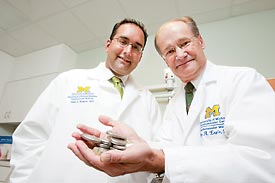Millions worldwide die each year because they can’t afford a pacemaker. Meanwhile heart patients in the United States say they’d be willing to donate theirs after death to someone in need.

Dr. Timir Baman (left) and Dr. Kim Eagle hope to make the concept of recycling pacemakers a life-saving reality for those who cannot afford them. Photo by Scott Galvin, U-M Photo Services.
In the Oct. 19 issue of Circulation, experts at the Cardiovascular Center examine the legality and logistics of collecting pacemakers, after they are removed for burial or cremation, for sterilization and reuse across the globe.
Small humanitarian efforts have shown reusing pacemakers is safe and effective with little risk of infection and patients live as long, and as well, with a recycled pacemaker as those who get new ones, authors say.
It’s a novel approach for treating cardiovascular disease, which remains the world’s leading cause of death.
“Establishing a validated pacemaker reutilization program could transform a currently wasted resource into an opportunity for a new life for many citizens in the world,” says study senior author Dr. Kim Eagle, cardiologist and a director of the Cardiovascular Center.
Pacemakers are implanted to correct a slow heartbeat. A slow heart rate can be caused by heart attacks, conductive diseases or old age, and lead to fainting and fatigue.
Each year 1 million to 2 million people worldwide die due to lack of access to pacemakers. But 84 percent of patients surveyed at the U-M would donate their pacemaker for reuse.
Through partnerships, the U-M hopes to make the concept of recycling pacemakers a life-saving reality for those who cannot afford them.
Some foreign manufacturers have reduced the cost of pacemakers to as little as $800, a price that still makes it out of reach in poor nations.
“Despite the substantial cost reduction, a new pacemaker is often more than the annual income of the average worker in underdeveloped nations,” Eagle says.
Growing evidence and support laid the groundwork for Project My Heart — Your Heart, a collaborative between citizens, physicians and funeral directors of Michigan, the Cardiovascular Center and World Medical Relief (WMR) Inc., a Detroit-based nonprofit organization that specializes in the delivery of used medical equipment.
Pacemakers removed before burial or cremations rarely are returned to the manufacturer and instead are stored at funeral homes with no apparent use. In a U-M survey of Michigan funeral home directors 89 percent said they were willing to donate devices to charitable organizations if given the opportunity.
According to study authors, after families consent, donated devices will be sent by the funeral home in a free postage-paid envelope to the U-M for assessment of battery longevity. Funeral directors can request packages from U-M.
If the device has a battery life greater than 70 percent, it will be sterilized and old patient information will be erased, with the ultimate goal of allocating devices to institutions throughout the world with assistance from WMR. “Of primary concern when discussing reuse of devices is the possibility of infection,” says lead author Dr. Timir Baman, a cardiology fellow.
“However, U-M physicians have examined previous studies involving device reutilization and found the overall infection rate of less than 2 percent is similar to that of new device implantation.”
Information about donating pacemakers to the U-M is available online at www.myheartyourheart.org.
Dr. Hakan Oral, director of the U-M cardiac electrophysiology service, also was an author on this paper.

